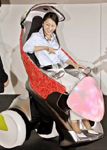Cue Entrance of the Gladiators. The 39th Tokyo Motor Show, a fortnight-long world revelation of all things that roll on motor-driven variations of the wheel and axle, is now underway. Japanese designers often proceed uninterrupted from laboratory logic to the convention dais, form following uninhibited intent so closely that the showpiece is what many other designers would be content to leave as a curious maquette, a paperweight, on the edge of their desks or drawing boards, safe inside the office — too embarrassed to present straight out of the sketchbook. For Japan's automobile industry, then, there is éclat in a thoroughly ludicrous concept car.
 Placing a bag of flour on top of a cutting board and two rolling pins normally results in Mother's praise and polite request for the missing items' eventual return. Nissan tried it and got "Pivo." An electric-powered people-mover, Pivo's distinction is its bulbous, revolving cabin which shall, the car company promises, bring an end to terms such as "hood" and "trunk" — and the need to back out of a driveway. When scuttling about town, families of three will be pleasantly acquainted with doubly large windows and the element of yaw. On which side does one fasten bumper stickers? Both; you may now choose twice as many. What happens when the cockpit swivels perpendicular or opposite to Pivo's forward bearing while on the interstate? Ensuing high-velocity hilarity. The car's wheels do not allow for horizontal motion, so parallel parking will remain an automotive tradition.
Placing a bag of flour on top of a cutting board and two rolling pins normally results in Mother's praise and polite request for the missing items' eventual return. Nissan tried it and got "Pivo." An electric-powered people-mover, Pivo's distinction is its bulbous, revolving cabin which shall, the car company promises, bring an end to terms such as "hood" and "trunk" — and the need to back out of a driveway. When scuttling about town, families of three will be pleasantly acquainted with doubly large windows and the element of yaw. On which side does one fasten bumper stickers? Both; you may now choose twice as many. What happens when the cockpit swivels perpendicular or opposite to Pivo's forward bearing while on the interstate? Ensuing high-velocity hilarity. The car's wheels do not allow for horizontal motion, so parallel parking will remain an automotive tradition.
 Toyota describes "I-Swing," its roundabout answer to the Segway, as "emotional." The wheeled hair dryer chair is built to reflect its single operator's mood or clothing — feeling fire-engine paisley today? I-Swing can oblige. Intended for pedestrian use the vehicle can simultaneously reach faster speeds and channel Artoo-Deetoo by extending a third, front wheel. The Japanese mentality for robotics is very much at work here: It is reported that Toyota wishes to use "artificial intelligence" for I-Swing's adaptability; and a spokesman referred to the scooter's development as a process of "evolving," rather than "refining." We know that Toyota is excited about I-Swing's transformation of the daily commute. Judging by its prevailing color, is I-Swing?
Toyota describes "I-Swing," its roundabout answer to the Segway, as "emotional." The wheeled hair dryer chair is built to reflect its single operator's mood or clothing — feeling fire-engine paisley today? I-Swing can oblige. Intended for pedestrian use the vehicle can simultaneously reach faster speeds and channel Artoo-Deetoo by extending a third, front wheel. The Japanese mentality for robotics is very much at work here: It is reported that Toyota wishes to use "artificial intelligence" for I-Swing's adaptability; and a spokesman referred to the scooter's development as a process of "evolving," rather than "refining." We know that Toyota is excited about I-Swing's transformation of the daily commute. Judging by its prevailing color, is I-Swing?
 Diphthongs bring a nice cachet to dignified roadsters (ask Rolls Royce), so researchers at Keio University in Tokyo named their creation — the fastest electric car on Earth — "Eliica." Clocking nearly one-third the speed of sound, the eight-wheeler confronts the stigma of battery-powered cars as slow, unmaneuverable and unattractive; while embodying the characteristics of inconvenient refueling and exorbitance. Lead designer Hiroshi Shimizu, seeking commercial and political support, is yet confident that those who want their very own bullet train will have it.
Diphthongs bring a nice cachet to dignified roadsters (ask Rolls Royce), so researchers at Keio University in Tokyo named their creation — the fastest electric car on Earth — "Eliica." Clocking nearly one-third the speed of sound, the eight-wheeler confronts the stigma of battery-powered cars as slow, unmaneuverable and unattractive; while embodying the characteristics of inconvenient refueling and exorbitance. Lead designer Hiroshi Shimizu, seeking commercial and political support, is yet confident that those who want their very own bullet train will have it.
For all of tomorrow seen today at the Motor Show, presenters remained human. This could mean that the bond between car and driver is inseparable — or else there is simply fine-tuning to do before the inevitable. Do androids dream of electric streetrods?